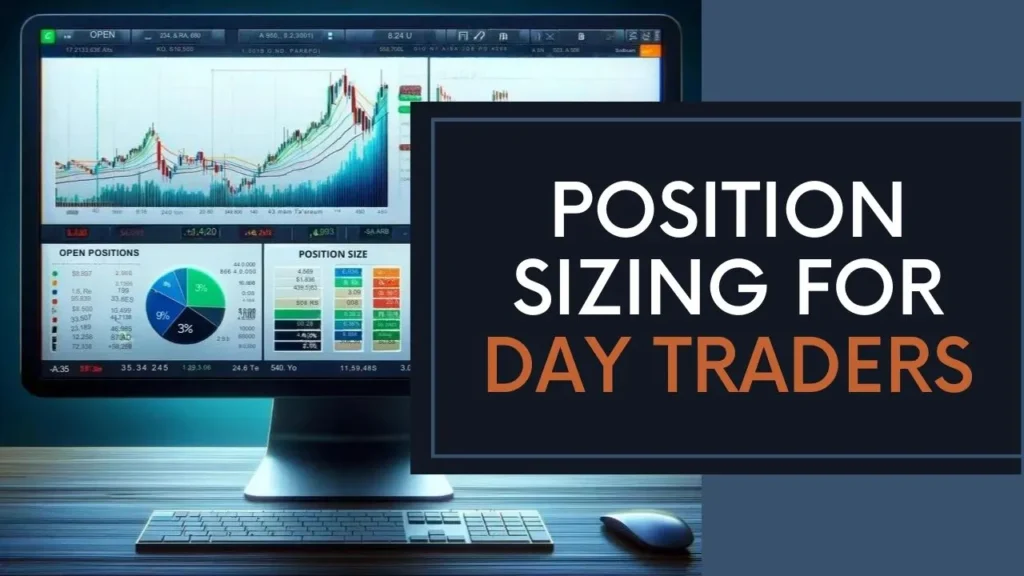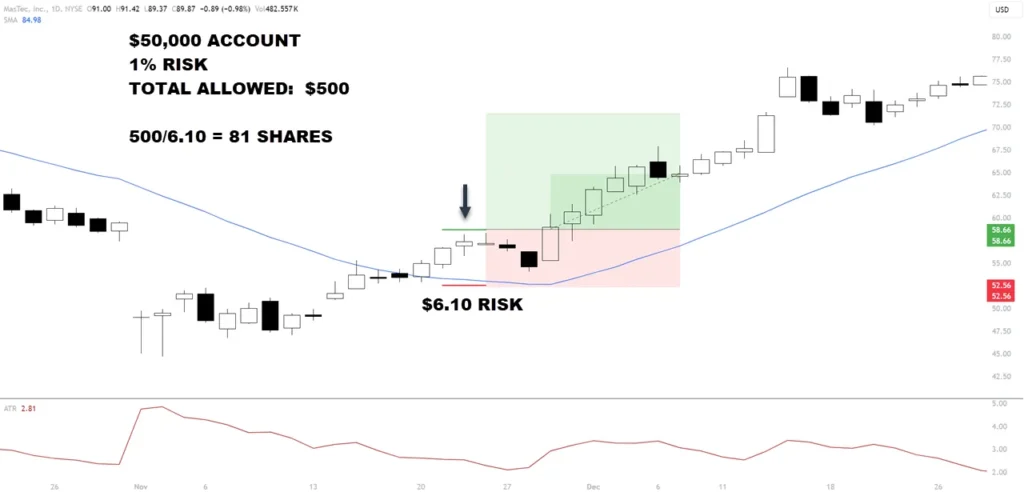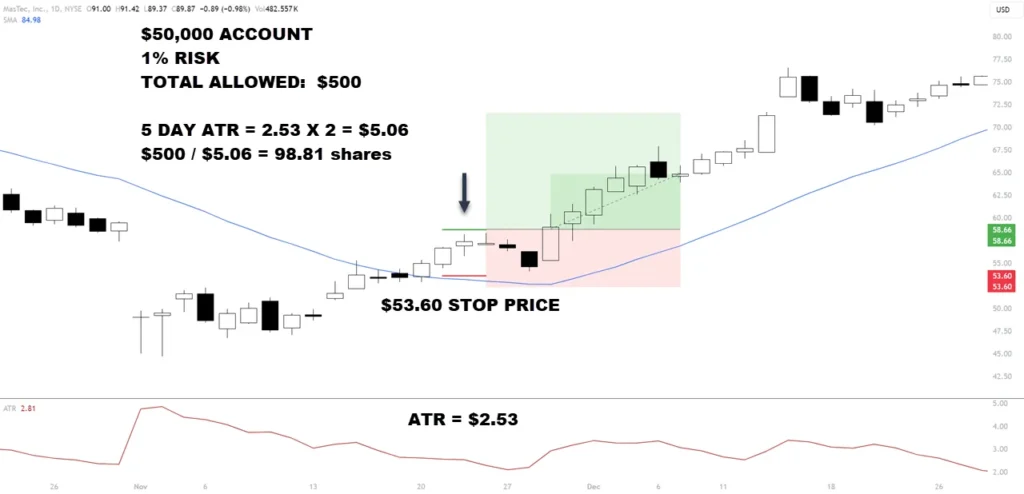- March 29, 2024
- Posted by: CoachShane
- Categories: Day Trading, Trading Article

To improve your day trading strategy, make sure you’re using effective position sizing methods. These methods are essential for managing risk and increasing your returns. When deciding on the right method for you, take into account factors like your account size, how much risk you can handle, and your stop-loss levels. Two popular methods to consider are Fixed Fractional Sizing and Volatility-Based Sizing.
 Fixed Fractional Sizing is a straightforward approach that aligns the size of your trades with your account balance. This helps maintain consistent risk levels across your trades. On the other hand, Volatility-Based Sizing adjusts the size of your positions based on indicators of market volatility. This can help you adapt to changing market conditions and optimize your risk management strategy.
Fixed Fractional Sizing is a straightforward approach that aligns the size of your trades with your account balance. This helps maintain consistent risk levels across your trades. On the other hand, Volatility-Based Sizing adjusts the size of your positions based on indicators of market volatility. This can help you adapt to changing market conditions and optimize your risk management strategy.
Dynamic Position Sizing allows you to adjust your position size in response to evolving market conditions. This flexibility is important for staying on top of risk management and maximizing your trading opportunities.
It’s important to understand the risks and psychological aspects involved in proper position sizing. By being aware of these factors and implementing the right position sizing method for your trading style, you can improve your overall day trading performance.
What is Position Sizing?
Position sizing is a skill that all day traders must be good at. It involves figuring out how many shares or contracts to trade based on your risk parameters. This means considering factors like your account size, how much risk you’re willing to take, and where you’ll set your stop-loss levels to manage risk effectively.
By carefully managing your position size, you can avoid account-damaging losses and maximize returns in your day trading activities. Day traders use position sizing to allocate their capital and stay consistent in their trading strategy.
The main aim of proper position sizing for day traders is to find a balance between risk and reward. This is done by adjusting the size of your trades according to market conditions and your risk tolerance. Understanding how to calculate and apply the right position size is essential for controlling risk and increasing profits in your day trading efforts.
Key Factors in Determining Position Size
When deciding how much to use when day trading, consider your account size and risk tolerance. These are key factors that will help you determine the appropriate position size for each trade.
Here are some important things to keep in mind to effectively manage your positions:
- Account Size: Your account size is a huge factor in deciding how much you can risk on each trade. It’s important to only risk a small percentage of your total account balance on any single trade to protect your capital.
- Trade Risk: Calculating the trade risk is essential for proper risk management. This involves determining the distance between your entry point and your stop-loss level. By setting a stop-loss order, you can limit your potential losses on a trade.
- Market Volatility: Market volatility can significantly impact the size of your positions and the risks involved. Higher volatility may require smaller position sizes to mitigate risk, while lower volatility may allow for larger positions.
- Position Sizing Strategies: It’s important to utilize different position sizing strategies to adapt to changing market conditions. By diversifying your position sizes and adjusting them based on market volatility, you can optimize your risk management approach and potentially improve your overall trading performance.
Popular Position Sizing Methods for Day Traders
In day trading, you need to learn to manage risk and boost returns effectively. Day traders often use various position sizing methods to achieve this. One popular approach is the fixed dollar amount method. Here, traders limit their risk exposure by investing a specific dollar amount per trade.
This method ensures consistent risk management regardless of the account size.
For example: let’s say a day trader decides to allocate $200 per trade using the fixed dollar amount method. Regardless of whether their account holds $10,000 or $100,000, they would consistently invest $200 per trade.
Another commonly used strategy is the percentage risk method. With this method, traders determine position sizes based on a certain percentage of their account balance. By adjusting trade sizes according to the account size, traders can enhance their risk management practices. It helps in maintaining a balance between risk and reward in each trade.

Here is an example:
Let’s say you have a $50,000 trading account and you decide to risk 1% of your account on each trade. This means your maximum risk per trade is $500 ($50,000 x 0.01).
You want to buy shares of XYZ stock, which is currently trading at $58.66. You set a stop loss at $52.56, which is $6.10 below your entry price. To calculate your position size, you divide your maximum risk by your stop loss size: Position size = Risk amount / Stop loss size = $500 / $6.10 = 88 shares
So in this example, you would buy 88 shares of XYZ stock at $58.66. If your stop loss gets triggered and the stock falls to $52.56, you will lose $500, which is 1% of your account. If the stock rises, you can let your profits run or set a profit target
By using effective position sizing methods, day traders look to strike a balance between risk and reward in their trades.
Fixed Fractional Sizing
When you use Fixed Fractional Sizing, you’re essentially risking a set percentage of your account on each trade. This approach helps day traders manage risk by adjusting their position sizes based on their account balance. Here’s what you need to know about Fixed Fractional Sizing:
- Risk Management: With Fixed Fractional Sizing, you make sure that the size of each trade is in line with your account balance. This helps you control and manage your risk effectively.
- Consistent Risk Levels: By sticking to this method, traders aim to maintain a consistent level of risk across all their trades. This can lead to more stable trading outcomes and minimize potential losses.
- Popular Among Day Traders: Many day traders prefer using Fixed Fractional Sizing for its simplicity and its ability to help them control their losses. It’s a popular choice in the trading community.
- Scalability: This method allows traders to adjust their positions based on their account size and risk tolerance. It gives traders the flexibility to adapt to different market conditions and scale their trading activities accordingly.
Volatility-Based Sizing
Are you looking to use more advanced day trading risk management strategies? Consider using market volatility indicators like Average True Range (ATR) to determine optimal position sizes. Volatility-based sizing involves adjusting your position size based on the current market volatility levels.
By analyzing indicators such as ATR, you can measure the volatility in the market and make informed decisions about your position sizes. This approach helps you adapt to changing market conditions and varying risk levels effectively.
Using volatility-based sizing in your trading strategies can significantly improve your risk management practices. By staying up to date about market volatility and adjusting your position size, you can better control your risk exposure and optimize your trading performance.
This method allows you to make more calculated decisions in response to the ever-changing market conditions, ultimately improving your overall trading outcomes.
Percent Volatility Model
The Percent Volatility Model helps day traders calculate the size of their positions based on market volatility. It uses the average true range (ATR) to account for the price movement range.
The ATR will indicate how much a particular stock moves on average over the period set with the ATR. We then use a multiple of that movement to help calculate our stop-loss level and the number of shares we can trade.
Here’s what you need to know about this model:
- Adjusting to Market Conditions: This model changes position size according to how volatile the market is at any given time. This helps day traders match their risk exposure with the current level of volatility.
- Managing Risk: By considering market volatility with ATR, day traders can effectively manage their risk and steer clear of overleveraging, especially in highly volatile markets.
- Adaptable Strategy: The Percent Volatility Model gives day traders the flexibility to adjust their position size dynamically. This allows them to respond to the evolving nature of market volatility.
- Enhancing Returns: By determining position size based on market volatility, traders can optimize their returns by tweaking their risk levels to suit the prevailing market conditions.
Example:

You want to buy shares of a stock currently trading at $58.66 and are willing to risk no more than $500 on the trade.
- The stock has a 5-day ATR of $2.53
- You will use a multiple of 2 for the stop-loss
- You want to buy the stock at $58.66
- You are willing to risk $500
First, calculate the stop loss level using the ATR:
- 2 x ATR = 2 x $2.53 = $5.06
- If you buy at $58.66, your stop loss would be placed at $53.60 ($58.66 – $5.06)
Now calculate your position size based on your $500 risk:
- Risk per share = Entry price – Stop loss price
= $58.66 – $53.60 = $5.06 - Position size = Total risk / Risk per share
= $500 / $5.06 ≈ 98.81 shares
Since you can’t buy fractional shares, you would round down to 98 shares. So in this example, to stay within your $500 risk tolerance, you would buy 98 shares of the stock at $58.66 with a stop loss of $53.60.Your total investment would be:
- 98 shares x $58.66 per share = $5,748.68
If the stock hits your stop loss at $53.60, your total loss would be:
- 98 shares x ($58.66 – $53.60) = $496.88
This is close to but does not exceed, your $500 risk limit. By using ATR to set your stop loss and calculate your position size, you can adapt your trading to the stock’s recent volatility while maintaining a consistent risk level per trade.
This model offers day traders a data-driven approach to sizing their positions, improving risk management practices, and aligning their trading strategies with the current market environment.
Dynamic Position Sizing – Best Approach?
Dynamic Position Sizing is about adjusting your trade sizes based on what’s happening in the market. It’s like fine-tuning your risk management strategy to match the current volatility levels and other risk factors. By being proactive and flexible in changing your position size, you can better control your exposure and stay on top of market fluctuations.
This approach allows you to optimize your risk management and adapt to the ever-changing market conditions effectively.
When you use Dynamic Position Sizing, you’re tailoring your trade sizes to fit the market environment you’re trading in. This means you can adjust your position size as needed to align with the volatility levels and other risk factors that are at play.
The key benefits of Dynamic Position Sizing are clear:
- It helps you adjust to market conditions, enhancing your risk management capabilities.
- You can increase your adaptability and make data-driven trading decisions.
- Allows you to control your risk exposure effectively, promoting flexibility.
Dynamic Position Sizing is a valuable tool for day traders looking to stay ahead of the curve and improve their overall risk management approach.
Importance of Stop Losses
Stop losses are like your safety net against unexpected losses in day trading. They’re needed for managing risk and protecting your trading capital, especially when the markets are volatile.
| Benefit | Description |
|---|---|
| Limiting Losses with Stop Loss | Stop-loss orders help you set a predetermined exit point for trades, enabling you to control losses and prevent them from escalating. |
| Risk Management | Stop loss ensures that no single trade significantly impacts your overall portfolio, aiding in spreading out risk and mitigating heavy losses. |
| Protection of Trading Capital | In turbulent market conditions, stop-loss orders safeguard your capital from substantial losses that could potentially deplete your account. |
| Maintaining Discipline | By adhering to predetermined exit points, stop-loss orders promote discipline in trading, discourage emotional decision-making, and encourage adherence to your trading plan. |
Adapting to Changing Market Conditions
You need to stay flexible in how you approach position sizing to adapt to changing market conditions. Market volatility can change quickly, affecting the risk in each trade. This calls for adjusting your position size to match your risk management strategy. By using dynamic position sizing tactics, you can take trade opportunities while safeguarding your capital from potential market downturns.
Using tools like stop-loss orders is another way to stay nimble in response to market changes.
These orders help limit losses and preserve your trading capital, adding an extra layer of protection. Keeping an eye on market trends and news is also essential for making good decisions when it comes to adjusting your position size.
Risks of Poor Position Sizing
Poor position sizing can be a real headache for day traders. It can lead to big losses and make it harder to succeed in the long run. Let’s break down the risks of poor position sizing so you can avoid these pitfalls:
| Potential Risk | Consequence |
|---|---|
| Exceeding Risk Tolerance | Getting the right position size is key to managing risk well. If you make poor sizing choices, you might end up facing losses that go beyond your comfort level. |
| Account Depletion | Messing up your position sizing could drain your trading account faster. This means you might miss out on future trading chances because your funds are low. |
| Amplified Market Volatility Impact | When you don’t size your positions correctly, market volatility and unexpected price swings can hit you harder. This raises the risk of facing large losses. |
| Emotional Decision-making | Choosing the wrong position size might lead to emotional trading decisions and impulsive moves. This can make your trading risks even worse. |
Psychology of Proper Position Sizing
Proper position sizing in day trading is a key step for managing your emotions and making better decisions. It helps you stay consistent and successful by matching your trade sizes with your risk tolerance, account size, and predetermined stop-loss levels. This approach keeps you disciplined in your day trading activities and reduces the impact of individual trade outcomes on your overall performance.
It also helps you overcome psychological biases like the fear of missing out (FOMO) and the fear of loss.
By using different position sizing techniques, you can trade alongside a plan. This reduces impulsive behaviors and improves your ability to make well-thought-out decisions in the day trading environment. Understanding the psychological aspects of trading and using proper position sizing methods can give you more confidence and consistency whenever you enter a trade.
Avoiding Overconfidence
Avoid getting too cocky in day trading, as it can lead you to take risky moves that might result in losses that didn’t need to happen. To avoid falling into the overconfidence trap, here are some tips:
- Stay grounded: Always remember the risks that come with day trading and stick to your risk management plans to avoid unnecessary gambles.
- Check your performance regularly: Take a step back now and then to review how you’ve been trading. This helps you see things objectively and spot any signs of overconfidence sneaking in.
- Get some feedback: Don’t hesitate to chat with other traders or mentors for fresh viewpoints on your trading methods. Constructive criticism can help you stay on track and avoid overconfidence pitfalls.
- Stick to your plan: Follow through with your set position sizes and capital allocation strategies. This way, you can steer clear of impulsive decisions driven by overconfidence and stay focused on your goals.
Managing Emotions
Controlling your emotions is key in day trading. It helps you make smart decisions and avoid acting on impulse. Your emotions can influence your trades, leading to irrational decisions driven by fear or greed. Stick to your trading plan to prevent emotions from clouding your judgment.
By staying disciplined, you can base your decisions on market analysis rather than impulsive feelings (these tend to never work out long-term).
Market volatility can trigger strong emotions, so it’s important for day traders to build emotional resilience. Don’t let your emotions control your trades. Focus on following your strategies instead.
Keep a clear mind, stay focused on your goals, and resist the temptation to stray from your plan due to emotional ups and downs. By mastering emotional control, you can confidently navigate market volatility and improve your trading performance.
Conclusion
Mastering position sizing methods is essential for day traders like you. It helps you manage risks efficiently and optimize your trading strategies.
By taking into account factors such as your account size, risk tolerance, and market volatility, you can make well-informed decisions that will lead to profitable outcomes.
It’s important to avoid overconfidence and keep your emotions in check when determining your position size. This will help you navigate the complexities of trading with confidence and precision.
Remember to stay disciplined, stay informed, and keep refining your position sizing strategies for success as a day trader.
FAQ
What is position sizing for day trading?
Position sizing for day trading refers to determining the number of shares or contracts to trade in a single transaction based on factors such as risk tolerance, account size, and market conditions. It helps traders manage risk by ensuring they do not expose themselves to excessive losses on any single trade.
What should my position size be?
Your position size should be determined based on your account size, risk tolerance, and the specific trade setup. Generally, it’s recommended to risk only a small percentage of your account balance on any single trade, typically between 1% to 3% of your total capital.
What is a lot size for day trading?
Lot size for day trading refers to the number of shares or contracts traded in a single transaction. It depends on various factors such as the trader’s account size, risk tolerance, and the specific market being traded. Lot sizes can vary widely among different assets and trading strategies.
What is the 6% rule for pattern day traders?
The 6% rule for pattern day traders advises limiting losses to 6% or less of your trading capital on any single trade. This rule helps pattern day traders manage risk and preserve their capital, thereby improving their long-term trading success.
What is position sizing for dummies?
Position sizing for dummies refers to a simplified approach to determining the appropriate position size for trading, often targeted at beginners or those new to trading. It typically involves using basic formulas or rules of thumb (1-2%) to calculate position size based on account size and risk tolerance.
How do you manually calculate position size?
To manually calculate position size, you can use the formula: Position size = (Account balance * Percentage risk) / (Entry price – Stop loss price). This formula considers your account balance, the percentage of your capital you’re willing to risk, and the difference between the entry price and stop loss price of the trade.
What is the Kelly method of position sizing?
The Kelly method of position sizing is a mathematical formula used to determine the optimal fraction of your capital to allocate to each trade. It takes into account the probability of winning and losing trades, as well as the expected return on investment, to maximize long-term growth while minimizing the risk of ruin.
How do you calculate position size fast?
To calculate position size quickly, you can use online position size calculators or trading software that automates the process based on your account size, risk percentage, and other parameters. Additionally, memorizing common position sizing rules or using predefined trading plans can help expedite the calculation process during fast-paced trading situations.

